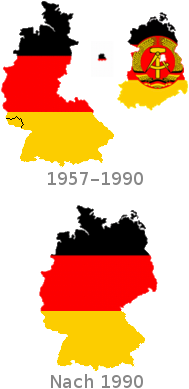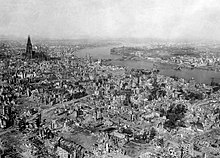West Germany
The history of the Federal Republic of Germany until 1990 deals with the history of the West German constituent state from 1949 to 1990. Even though the Federal Republic survived the reunification with the German Democratic Republic formed in 1949 in East Germany in 1990 without a break in terms of state law, historical research assumes a political and social caesura between the old Federal Republic until 1990 and the reunified Federal Republic since 1990. The history of the latter is described under History of Germany (since 1990).
The Federal Republic of Germany came into being after the defeat of the German Reich in the Second World War under the subsequent rule of the occupying powers in post-war Germany. At the instigation of the Western Allies, the territory of the Western occupation zones (Trizone) was reorganised as a state with the entry into force of the Basic Law drawn up by the Parliamentary Council on 24 May 1949. The Basic Law as a constitution is based on federal traditions and establishes the liberal-democratic basic order as the basis of a democratic, social and constitutional republic. The economic miracle that began when the consequences of the war were overcome brought widespread full employment and income increases for broad sections of the population, while the Nazi past was initially largely suppressed. From the 1960s onwards, liberalisation and westernisation processes followed, which manifested themselves in the '68 movement. From the 1970s onwards, the economic situation deteriorated with permanent base unemployment. New social movements emerged, which in the 1980s made environmental, anti-nuclear and women's issues relevant, among others. The initially tense relationship between the Federal Republic, which was integrated into the West, and the GDR during the Cold War was eased by the new Ostpolitik and ended after the peaceful revolution in 1989 with the establishment of German unity on 3 October 1990.

Federal Republic of Germany since the accession of the Saarland on 1 January 1957 and the enlarged Federal Republic since 3 October 1990
Initial situation 1945
→ Main article: Germany 1945 to 1949
At the unconditional surrender of the Wehrmacht on May 8, 1945, U.S., British, and French troops were on the territory of West Germany, and Soviet troops were on the territory of East Germany, including the entire city of Berlin. The Americans and British had initially occupied Thuringia and parts of Saxony, parts of what would later become Saxony-Anhalt and Mecklenburg. On the basis of prior agreements, the Western Allies withdrew in July 1945 to the territory in the west that had been defined in the treaty, and in return the Soviet Union vacated the western part of Berlin. Thus, in addition to the four occupation zones, the four-sector city of Berlin was created, governed jointly by all four powers, with one Soviet, one American, one British and one French sector each.
At the Potsdam Conference in August 1945, the three victorious powers, the United States of America, the Soviet Union and the United Kingdom, decided to place the German eastern territories beyond the Oder-Neisse line under the administrative sovereignty of the Soviet Union and Poland. They divided the remaining territory of the German Reich within the boundaries of December 31, 1937, into zones of occupation. France, which had only been recognized as the fourth victorious power at the Yalta Conference in February 1945 but had not participated in the conference, agreed to the agreement with reservations.
Three months earlier, the Soviet Union had already transferred the German eastern territories, with the exception of Königsberg and North East Prussia (today the KaliningradOblast), to the later People's Republic of Poland for administration. The Soviet Union received the territory of the later German DemocraticRepublic as an occupation zone. The United Kingdom claimed the territory of present-day Schleswig-Holstein, Hamburg, Lower Saxony and North Rhine-Westphalia. The American occupation zone covered Bavaria, Hesse, the northern parts of Württemberg and Baden. As a port city, Bremen and Bremerhaven came under American occupation. France received what later became Rhineland-Palatinate, the southern parts of Württemberg and Baden, and Saarland as an occupation zone; the latter did not become a state of the Federal Republic until 1957. The four victorious powers divided the former Reich capital Berlin into four sectors.
The Allied Control Council, based in Berlin, held supreme governmental power for the whole of Germany; the Allied Commandant's Office, subordinate to the Control Council, was responsible for Greater Berlin.
In the Eastern territories, Czechoslovakia and other East-Central European countries, the systematic expulsion of the German population began in the following period. Some 14 to 16 million people were expelled to the western as well as the Soviet occupation zones or had to flee, placing an additional burden on the already difficult situation; soon the majority of the population in some areas consisted of expellees.
In Germany itself, life in the partly bombed-out cities was very difficult due to a lack of housing as well as food shortages, destroyed infrastructure, lack of electricity and fuel shortages. Because many men were prisoners of war, rubble women cleared the debris in the cities. City dwellers drove en masse to the countryside on so-called hoarding trips to exchange food for material goods. The Reichsmark as the official currency no longer had any real value because of the extensive forced farming, the black market and trade in material goods flourished, and US cigarettes became a substitute currency. Numerous trees were cut down and coal trains looted because of the fuel shortage. Food was only available through food stamps or was homegrown.
The occupying powers ordered denazification, banned the NSDAP and its sub-organizations, and had all National Socialist symbols removed. Germans in the western occupation zones were systematically examined for their National Socialist past using questionnaires. However, there were numerous opportunities to obtain a so-called "Persilschein" on the black market. Numerous offices in the authorities had to be filled anew (in many places with old Nazis), and many new teachers were also trained for their profession in just a few months. On November 14, 1945, the trial of the main war criminals began in Nuremberg; on October 1, 1946, 12 of the 21 main accused (defendants) were sentenced to death. This was followed by subsequent trials of other war criminals.
See also: Legal situation of Germany after 1945

Cologne 1945

Occupied territories of the later Federal Republic of Germany, German Democratic Republic and Berlin 1945, but excluding the eastern territories of the German Reich under foreign administration
Occupy
→ Main article: Germany 1945 to 1949 and occupation zone
In 1946/47, most of today's West German federal states were created - in part by merging previously independent states and former Prussian provinces - and the first free local and state elections could be held. In February 1946, a Zonal Advisory Council was formed in the British Occupation Zone consisting of representatives of political parties, trade unions and the administration to advise the military government. On December 1, 1946, Hesse became the first state to adopt a post-war constitution. However, Article 41 of the Hessian constitution, which provided for the transfer of the businesses of the key industries to public ownership, was never implemented. With Konrad Adenauer as chairman of the CDU in the British zone and Kurt Schumacher as chairman of the SPD, two groundbreaking individuals entered the scene in the spring of 1946. In April 1946, the German courts resumed their work. Also that August, U.S. charities began delivering CARE packages to Germany and the GARIOA program to alleviate the famine; in September 1946, RIAS formed in Berlin. In his Stuttgart speech of September 6, 1946, U.S. Secretary of State James F. Byrnes emphasized his positive attitude in German policy and announced a change in German-American relations. He also hinted at a continuing Western Allied presence in Germany.
On January 1, 1947, the Bizone was created with the unification of the US and British occupation zones. Also in this month, the magazine Der Spiegel appeared for the first time. The Allied Control Council dissolved the State of Prussia in February 1947, thus preventing the Germans from turning back to their military traditions. On 5 June 1947 the Marshall Plan was launched and in July an Economic Council of the United Economic Area was formed to get economic life going again. The first works of post-war literature were presented at the meetings of Gruppe 47.
After the failure of the London Conference of Foreign Ministers in December 1947, the rift between the Western Allies and the Soviet Union became insurmountable. In the months of February and March 1948, the London Six-Power Conference took place with the USA, Great Britain, France, the Netherlands, Belgium and Luxembourg, which discussed the formation of a West German state and the Brussels Pact, an alliance to protect Western interests against the Soviet Union's quest for power. In protest against the decisions, the Soviet envoy left the Allied Control Council on March 20, which had thus failed. In 1949, in accordance with the decision of the six powers in London, the Allies regulated Germany's western border with the Netherlands, Belgium, Luxembourg, the Saar region and France. Some border areas (Elten, Selfkantgebiet) were annexed to the Netherlands, in return the Netherlands renounced the implementation of the Bakker-Schut plan.
Also in March 1948, Ludwig Erhard began his career in what would later become the Federal Republic as head of the "Economic Council" of the Bizone; at the same time, the Bank deutscher Länder, predecessor of the Bundesbank, was founded.
The introduction of the Deutschmark on 20 June 1948, which was accompanied by the currency reform in West Germany, and which was followed a few days later by the introduction of the DM East in the SBZ and Berlin, finally divided Germany into two economic areas. In contrast to the SBZ, in the western zones it also meant the end of the forced economy and thus quickly removed the basis for the black market there. After the Soviet Union had failed in Berlin with the introduction of the DM East as the only currency, it imposed the Berlin Blockade on the western sectors on 24 June 1948, to which the Western Allies responded with the airlift to Berlin from 26 June 1948.

Airlift memorial in Berlin-Tempelhof, popularly called "Hungerharke" or "Hungerkralle".
Search within the encyclopedia